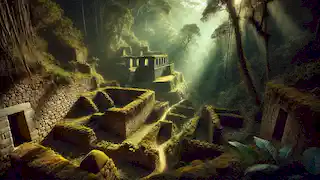The Legend of the Lost City of Vilcabamba
Reading Time: 8 min
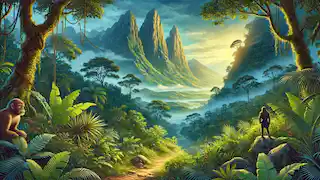
About Story: The Legend of the Lost City of Vilcabamba is a Legend from peru set in the Renaissance. This Dramatic tale explores themes of Perseverance and is suitable for Adults. It offers Historical insights. Discover the hidden legacy of the Last City of the Inca Empire.
In the heart of the rugged Andes Mountains of Peru, cloaked in dense jungle and steep ridges, lies a legendary city that has fascinated explorers, historians, and treasure hunters alike: Vilcabamba, the Last City of the Incas. Hidden from the world for centuries, Vilcabamba remains one of history's greatest mysteries. The tales of its grandeur, its wealth, and its secrets have been passed down through generations, growing richer with each telling. It was said to be the final stronghold of the Inca empire, the place where the last remnants of the mighty civilization retreated after the Spanish conquest. But did Vilcabamba ever truly exist as described? And if so, why has it remained hidden for so long? This is the legend of the Lost City of Vilcabamba. The story of Vilcabamba begins with the rise of the Inca empire, a civilization that, at its peak, spanned across modern-day Peru, Ecuador, Bolivia, Chile, and Colombia. From their capital, Cusco, the Incas ruled over millions of people, building monumental cities and developing intricate systems of agriculture, engineering, and government. Their roads, temples, and terraces still inspire awe today, standing as a testament to their ingenuity and power. Yet, as with all great empires, the Incas eventually faced challenges from within and without. In the early 16th century, the Spanish conquistadors arrived on the shores of South America, drawn by the tales of vast wealth and untold riches. Led by Francisco Pizarro, the Spaniards took advantage of the internal strife within the Inca empire, seizing Cusco in 1533 and capturing the Inca ruler, Atahualpa. With their capital fallen and their emperor dead, the Incas seemed defeated. However, resistance to the Spanish invaders did not end with the fall of Cusco. The surviving members of the Inca royal family fled into the remote corners of their empire, seeking refuge in the mountains and jungles. It is in this context that the legend of Vilcabamba truly begins. Manco Inca, a member of the Inca royal family, became the leader of the resistance against the Spanish. In 1536, he led a massive revolt, temporarily reclaiming Cusco from the conquistadors. However, the victory was short-lived, and the Spanish soon regained control. Forced to flee, Manco Inca led his followers deeper into the Andes, determined to preserve the legacy of the Inca empire. According to legend, Manco and his people embarked on a harrowing journey through the rugged mountain passes and thick jungles of the region, eventually reaching a remote valley that would become their sanctuary. Surrounded by towering peaks and dense forests, Vilcabamba was both a refuge and a fortress, hidden from the prying eyes of the Spanish. There, the Incas continued to resist the Spanish, launching raids and attacks on colonial outposts. Vilcabamba became the heart of the Inca rebellion, a symbol of defiance and hope for those who refused to submit to foreign rule. For nearly four decades, the city remained a thorn in the side of the Spanish authorities, who desperately sought to find and destroy it. Yet, despite their efforts, Vilcabamba eluded discovery, its location a closely guarded secret known only to the Incas themselves. The Inca resistance continued for many years, but by the late 16th century, the Spanish had grown stronger and more determined to wipe out the last remnants of the Inca empire. In 1572, they launched a final campaign to locate and capture Vilcabamba. Spanish forces, under the command of Viceroy Francisco de Toledo, relentlessly pursued the Incas, slowly tightening the noose around their hidden sanctuary. Despite their efforts to protect their city, the Incas could not hold out forever. After a series of battles, the Spanish finally breached Vilcabamba's defenses, capturing the city and executing the last Inca emperor, Tupac Amaru. With his death, the Inca empire was finally extinguished, and Vilcabamba was abandoned. Or so the story goes. For centuries after the fall of Vilcabamba, the city remained shrouded in mystery. Explorers, adventurers, and archaeologists alike were drawn to the idea of uncovering its ruins, believing that somewhere deep in the jungle, the Lost City of the Incas awaited rediscovery. The few written accounts from the time described Vilcabamba as a place of great beauty and wealth, filled with treasures that had been hidden from the Spanish. One of the most famous explorers to seek out Vilcabamba was Hiram Bingham, an American historian and explorer. In 1911, Bingham embarked on an expedition into the Peruvian Andes, guided by local indigenous people and armed with vague descriptions of the lost city. What he found, however, was not Vilcabamba, but another Inca site altogether: Machu Picchu. Machu Picchu, now one of the most iconic archaeological sites in the world, was an astonishing discovery in its own right, but it was not the fabled Lost City of Vilcabamba. Bingham continued his search, eventually uncovering the ruins of a site known as Espíritu Pampa, deep in the jungle. Many scholars now believe that Espíritu Pampa is the true location of Vilcabamba, though the debate continues to this day. The legend of Vilcabamba is more than just a story of an ancient city hidden in the jungle—it is a tale steeped in myth and mystery. Over the centuries, the city has become the subject of countless rumors and theories. Some believe that Vilcabamba was a place of unimaginable riches, its walls lined with gold and silver, and that the Incas managed to hide their most valuable treasures there before the Spanish arrived. Others suggest that the city held powerful spiritual significance, serving as a place of worship and pilgrimage for the Inca people. There are also those who claim that Vilcabamba was not merely a city, but a utopia—a place where the Incas perfected their society, living in harmony with nature and each other. In this version of the story, the city's destruction at the hands of the Spanish is seen as a tragic loss, not just for the Inca people, but for humanity as a whole. These myths and mysteries have fueled the imaginations of generations of explorers, leading to countless expeditions into the remote regions of the Peruvian jungle. But despite the many attempts to find definitive proof of Vilcabamba's existence, the city remains elusive, its true story hidden beneath the layers of time and legend. Though the exact location and nature of Vilcabamba remain uncertain, its legacy continues to resonate in modern-day Peru and beyond. The city represents the final chapter in the story of the Inca empire, a symbol of resilience and defiance in the face of overwhelming odds. For the descendants of the Inca people, Vilcabamba is a reminder of their rich cultural heritage and the sacrifices made by their ancestors to protect their way of life. In recent years, archaeologists have made new discoveries that may shed light on the true nature of Vilcabamba. Excavations at Espíritu Pampa have uncovered artifacts and structures that suggest the site was indeed a major Inca settlement, possibly even the fabled lost city itself. But even as these discoveries bring us closer to understanding the past, they also raise new questions. Was Vilcabamba truly a last stand for the Inca empire, or was it simply one of many hidden cities scattered throughout the Andes? What secrets did its inhabitants take with them when the city fell? And why, after all this time, does the legend of Vilcabamba continue to captivate our imaginations? As we reflect on the legend of the Lost City of Vilcabamba, we are reminded of the enduring power of myths and the way they shape our understanding of history. Vilcabamba may be a real place, hidden away in the jungles of Peru, or it may exist only in the minds of those who seek it. Either way, its story speaks to something deeper within us—a longing for discovery, a desire to uncover the unknown, and a fascination with the past. In many ways, the search for Vilcabamba is not just about finding a lost city—it is about reconnecting with a lost part of ourselves. The Inca empire, though long gone, continues to cast a long shadow over the present, reminding us of the incredible achievements of ancient civilizations and the fragility of human endeavors. Perhaps one day, the mystery of Vilcabamba will be solved, and its secrets revealed to the world. Or perhaps the city will remain lost forever, its legend growing ever larger with time. For now, Vilcabamba remains an enigma, a tantalizing puzzle waiting to be pieced together by those brave enough to venture into the heart of the Peruvian jungle. Until that day comes, the Lost City of Vilcabamba will continue to inspire, intrigue, and captivate all who hear its story.The Rise of the Inca Empire
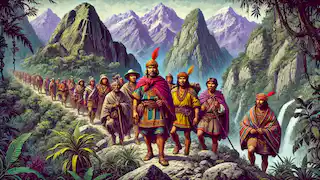
The Journey to Vilcabamba
The Fall of Vilcabamba
The Search for the Lost City
The Myths and Mysteries
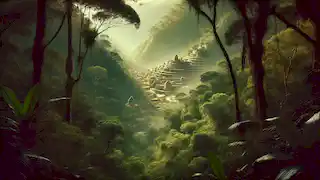
The Legacy of Vilcabamba
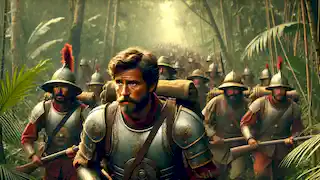
The Enduring Mystery
